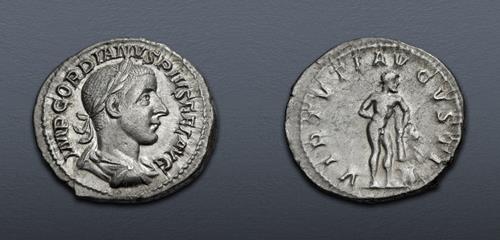
|
Gordian III. AD 238-244. AR Denarius (20mm, 3.17 g, 12h). Rome mint, 4th officina. 8th-11th emissions, late AD 240-early 243. Good VF.
Electronic Auction 589
Lot: 647. Estimated: $ 100
Roman Imperial, Silver
Sold For $ 170. This amount does not include the buyer’s fee.
Go to Live
|
|
Gordian III. AD 238-244. AR Denarius (20mm, 3.17 g, 12h). Rome mint, 4th officina. 8th-11th emissions, late AD 240-early 243. Laureate, draped, and cuirassed bust right / VIRTVTI AVGVSTI, the “Farnese” Hercules standing right, holding Apples of the Hesperides in right hand behind back and club set on rock in left; lion skin beside club. RIC IV 116; RSC 403. Lightly toned. Good VF.
From the Dennis E. McAvoy Collection. Ex Elwood Rafn Collection (CNG inventory 997315, February 2015).
This reverse type is modelled after, or based on the same subject as, the famed marble Farnese Hercules statue that was discovered in the excavations of the Baths of Caracalla in 1546. It stood for over 200 years in the Palazzo Farnese in Rome, from whence it gained its name, and was moved to Naples in 1787, where it is now displayed in the Museo Archeologico Nazionale. The statue is thought to be an enlarged copy sculpted in the early 3rd century AD by Glykon based on an original by Lysippos dating to the 4th century BC. The statue depicts Hercules at rest after completing his Labors: he is shown standing with his club, draped in the skin of the Nemean Lion, set upright on a rock, propped under his left arm supporting the weight of his muscular frame, his head slightly nodding forward in a weary attitude, and he holds the apples of the Hesperides behind his back in his right hand. The sculpture was apparently well-liked by the Romans, and copies have been found in Roman palaces and gymnasiums.
Closing Date and Time: 18 June 2025 at 13:35:20 ET.
All winning bids are subject to a 20% buyer’s fee.
|
